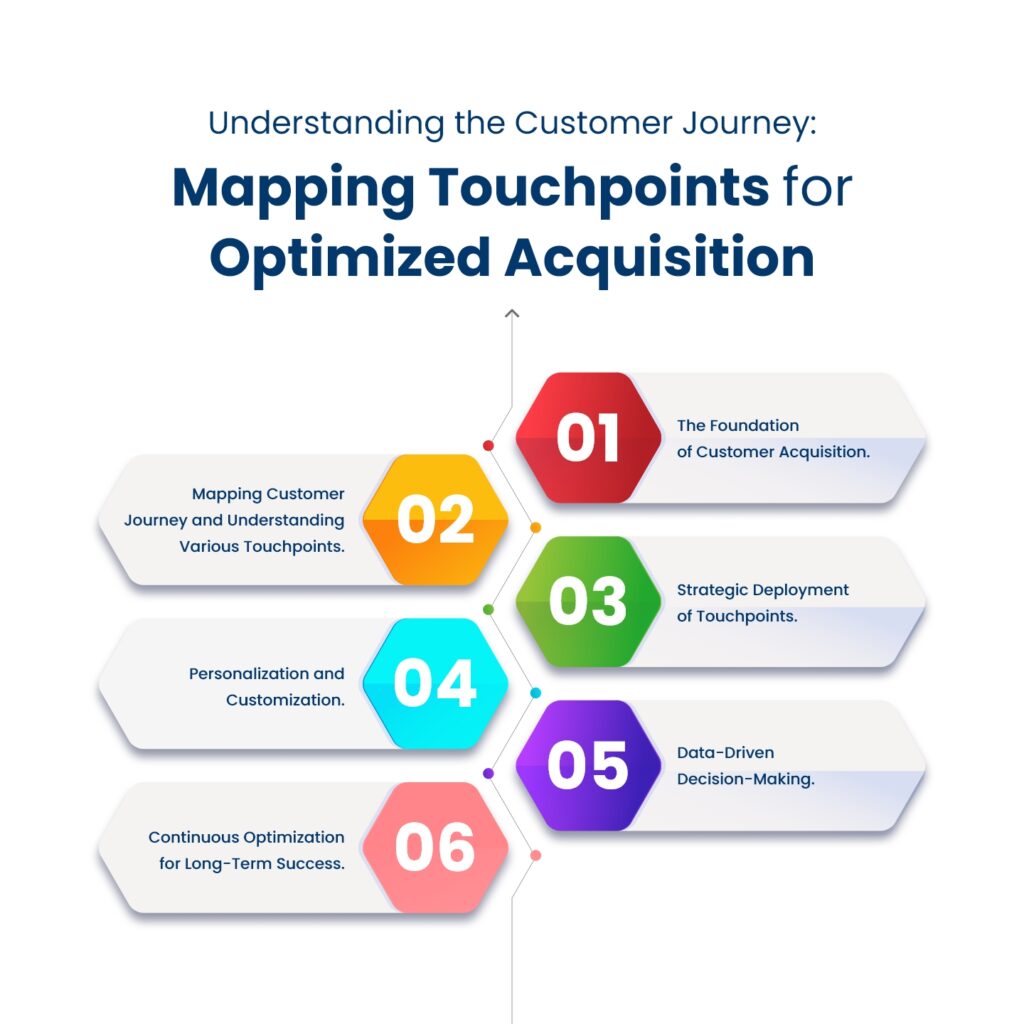The significance of a robust customer acquisition strategy cannot be overstated. As companies strive to expand their market reach and foster sustainable growth, understanding the customer journey becomes pivotal. Today, 44% of businesses focus on customer acquisition, while only 18% focus on customer retention. Also, the probability of selling to an existing customer is between 60% and 70%. Against this backdrop, we delve into the intricate process of mapping customer touchpoints to optimize acquisition strategies, enhancing the overall effectiveness of a business’s approach.
The Foundation of Customer Acquisition:
A well-defined customer acquisition strategy serves as the cornerstone of a successful business. The first step in this journey involves identifying and understanding the customer’s needs, desires, and pain points. By aligning products or services with these insights, businesses can tailor their approach to address specific customer demands.

Mapping Customer Journey and Understanding Touchpoints
To create an effective customer acquisition strategy, it is crucial to map the customer journey comprehensively. This entails identifying and analyzing various touch points throughout the customer lifecycle. A touchpoint refers to any interaction a customer has with a brand, be it through online platforms, social media, customer service, or physical stores. In the digital era, machine learning recommendation systems have emerged as indispensable tools for refining customer touchpoints. These systems analyze vast datasets to provide intelligent customer insights, helping businesses personalize their interactions. Understanding the touchpoints allows businesses to gain insights into customer behavior, preferences, and decision-making processes. Here are some common touch points that are the cornerstones in mapping the customer journey:
- Online Presence:
A company’s website is often the first point of contact. It should be user-friendly, informative, and aligned with the brand’s message. In the case of social media, platforms like Facebook, Twitter, Instagram, and LinkedIn serve as touchpoints where customers can engage with the brand and its community.
- Content and Marketing:
Informative blog content can attract and educate potential customers. Email newsletters and promotions provide a direct line of communication with customers. SEO continues to rise as a priority for marketing teams across the globe as 64% of marketers said they are actively invested in SEO. So, put in the time to learn SEO strategies, stay up to date with trends, and optimize your blog posts.
- Sales and Purchase Process:
E-commerce Platforms entail the actual process of browsing, selecting, and purchasing products or services online. Also, Point of Sale (POS), in physical retail, and the entire checkout process is a critical touchpoint.
- Customer Service:
Live Chat refers to real-time assistance for customers on the website. Moreover, phone support and email support handle customer queries and issues through email.
- Post-Purchase Experience:
Order Confirmation and follow up communication are crucial. They provide reassurance after a purchase, along with surveys, feedback requests, and personalized recommendations.
- Physical Touchpoints:
Brick-and-mortar stores facilitate in-person interactions and transactions, offering customers a hands-on experience. Events like trade shows and product launches further enhance engagement by providing physical opportunities for customers to connect with the brand.
- Referral and Advocacy:
Referral programs incentivize customers to recommend products to friends and family, fostering word-of-mouth marketing. Simultaneously, user reviews play a pivotal role in shaping a brand’s reputation, with positive testimonials enhancing credibility and trust among potential customers.
- Mobile Interactions:
Mobile apps enable direct interactions with a company’s services, offering convenience and accessibility. Meanwhile, SMS notifications provide timely alerts and updates, delivering information directly to the customer’s mobile device for seamless communication.
- Community Engagement:
Forums and discussion boards serve as online platforms where customers can openly discuss products and share their experiences. Additionally, user groups create communities centered around shared interests or product usage, fostering a sense of connection among like-minded individuals.
- Feedback and Surveys:
Customer surveys play a crucial role in gathering feedback to gauge satisfaction levels and pinpoint areas for improvement. These insights are invaluable for businesses seeking to enhance their products or services and tailor their offerings to meet customer expectations more effectively.
Strategic Deployment of Touchpoints:
In the digital age, customer touchpoints have expanded exponentially, ranging from social media platforms and websites to email campaigns and customer service channels. Effectively leveraging these touchpoints requires a strategic approach that aligns with the overall customer acquisition strategy. Interestingly, in a HubSpot Research study, it has found that 81% of consumers trust the advice of family and friends over businesses. Hence, creating a customer acquisition strategy that only relies on salespeople would put your company in a tough spot. Keep your strategy pliable, and you’ll always be ready to respond to market trends.
Also, social media platforms can be powerful tools for creating brand awareness and engaging with potential customers. Businesses targeting Gen Z might consider creating videos as part of their content marketing strategy, given that 77% of teens and young adults ages 15-25 use YouTube. By maintaining consistency across touchpoints, businesses can reinforce their brand image and build trust with their audience. Also, smart shopping campaigns, powered by machine learning algorithms, represent a dynamic touchpoint in the customer acquisition journey.
Personalization and Customization:
One key aspect of optimizing touchpoints is the implementation of personalized and customized experiences. Customers appreciate a tailored approach that caters to their individual preferences. Integrating the customer acquisition strategy into personalization efforts ensures that each touchpoint resonates with the target audience, increasing the likelihood of conversion.
For example, e-commerce platforms can use customer data to recommend products based on past purchases, browsing history, and preferences. This level of personalization not only enhances the customer experience but also strengthens the customer-brand relationship, fostering loyalty and repeat business.
Data-Driven Decision-Making:
A pivotal touchpoint in the customer journey is the moment of decision-making. A well-designed product recommendation system, fueled by machine learning algorithms, aids customers in making informed choices. In the realm of customer acquisition, data is a powerful ally. Analyzing customer data allows businesses to gain valuable insights into the effectiveness of various touchpoints and the overall customer journey. By incorporating the customer acquisition strategy into data analysis processes, businesses can identify patterns, trends, and areas for improvement. This iterative approach ensures that the customer journey mapping remains dynamic and responsive, optimizing the overall acquisition strategy over time.
Continuous Optimization for Long-Term Success:
Customer acquisition is an ongoing process that requires continuous optimization. As market dynamics evolve and customer expectations shift, businesses must adapt their strategies accordingly. By regularly revisiting and refining touchpoints in alignment with the customer acquisition strategy, companies can stay ahead of the competition and secure long-term success.
Takeaway
In the fast-paced world of business, understanding the customer journey and strategically mapping touchpoints is integral to a successful customer acquisition strategy. So, as the landscape continues to evolve, companies that prioritize comprehensive journey mapping will undoubtedly stand out, ensuring sustained growth and a competitive edge in the market.


